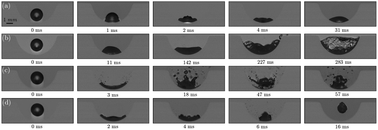Rebounding suppression of droplet impact on hot surfaces: effect of surface temperature and concaveness
Abstract
When a droplet impinges on a hot surface it is crucial to increase the contact time or decrease the rebounding distance if the heat transfer between the droplet and the surface is important. This will be more sensitive when the temperature regime is above the Leidenfrost values. The focus of the present experimental study is on the maximum height of drop bouncing after impinging on flat and semi-cylindrical concave surfaces, in particular in terms of surface temperature. It is shown that the behavior of the lamella during the spreading to its maximum diameter has a considerable impact on the maximum height of the drop bouncing. For different impact Weber numbers the map of thermal versus inertia effects is extracted for both the flat and concave surfaces for rebound and thermal atomization mid-regimes. It was shown that the thermal atomization mid-regime was eliminated in the case of drop impact on the concave surface in a wide range of impact Weber numbers and surface temperatures. The variations in rebounding and maximum heights at different regions of the maps are quantified and discussed. The morphology of drop impact on the concave surface was captured and the influence of its asymmetric deformation on extensive suppression of drop bouncing was discussed. Finally, the amount of dissipated energy due to drop deformation was obtained based on an energy balance analysis.



 Please wait while we load your content...
Please wait while we load your content...